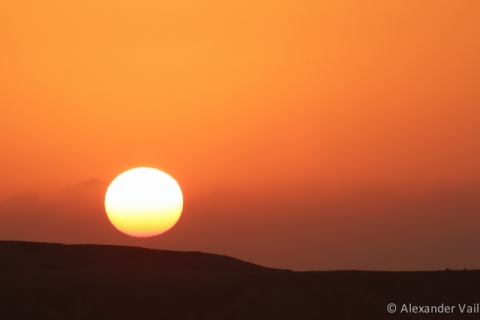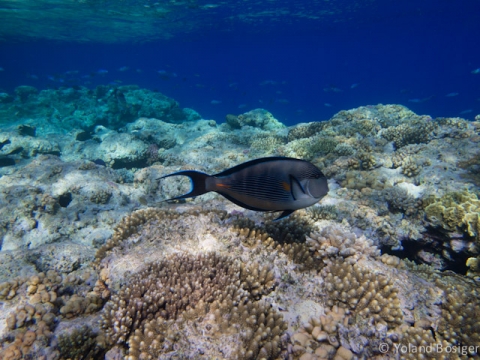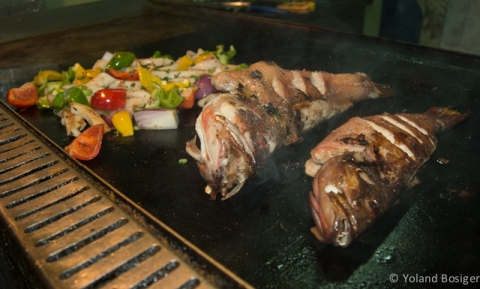The scrupulous beep of my alarm shakes me awake and I reluctantly make my way to the door of the Bedouin tent. I can already hear the sound of waves crashing on the sand and as I peep my head out the smell of cool salty air greets me. Like an oil pastel painting, the pinky purple sky blends flawlessly into the pale blue ocean. Lets just say there is definitely no cure for an offensive wake up quite like Ras Mohammed National Park.
I had come to the Sanai Peninsular to help my partner, Alexander Vail make a short movie trailer about overfishing in the Red Sea. So far, I have really enjoyed improving my underwater videography skills and so I was stoked with the opportunity to help out. I was also extremely excited to see a bit of the Red Sea; a place where coral and fish communities vary greatly to the Indo Pacific.
Our first stop was Dahab, which is about an hour’s drive south of Sharm el-Sheikh and we organised to stay with Salem Hassen, a local Egyptian dive shop owner who has helped students in Alex’s laboratory on many occasions. Salem was extremely kind to us during our stay, providing fantastic accommodation, dive facilities and transfers. We even got delicious home cooked lunches made fresh every day by Salem’s mum.
Diving in the Red Sea was a phenomenal experience and I was completely blown away by the vivid colours of reef. Up until now, I’d really believed that those bright red and orange reef photos sold in tourist superstores were the result of clever Photoshop enhancement. Yet in Dahab those reefs were genuinely right in front of my eyes. For someone who is also used to travelling 40 min on a boat to get to the reef, Dahab was extremely convenient. All you need to do is grab your dive gear and swim off the beach!
On our first dive, Alex and I were lucky enough to spot a huge Maori wrasse Chelinus undulatus, almost straight away. We got some great film of it feeding on shellfish with its huge protractile jaws that can make mincemeat of even the toughest prey. We were pretty stoked for our first attempt at getting one of the Red Sea’s big predators on film. Maori wrasse are faring reasonably well in the touristic areas of the Red Sea, but sadly the same cannot be said for one of the other major predators, the grouper.
Our task was to film groupers in restaurants in Dahab – unfortunately one of the most reliable places to see these beautiful fish these days. The whole effort took about three days and involved numerous and often repeat conversations with restaurant doormen. I think by the third day the guys just thought that Australians were nice (but very crazy), especially after we waited an entire hour for a person to order grouper so that we could film it being taken to their table.
To capture the stunning beauty of the Red Sea reefs our best bet was to go to Ras Mohammed National Park. The park is located 12 km from the city of Sharm el-Sheikh and spans an area of 480 km2. Once again we stayed with friends of Alex’s University, this time a local Bedouin named Gomaa Awad and his two nephews. Gomma runs a very small tourist camping operation consisting of one to two Bedouin tents in Mersa Bereika, a small bay inlet in Ras Mohammed.
Staying with Gomaa and learning more about the Bedouin culture was definitely one of the coolest experiences I have had this year. The term Bedouin derives from a plural form of the Arabic word badaw? which means “those in the desert”. The Bedouin have lived an often highly unstable and turbulent life in the Sinai. Currently many of the Bedouin are in transition from a largely nomadic life to a more Western lifestyle where tourism is the main form of employment. With the advent of new democracy last year, the Bedouin are hoping for more rights and freedoms to education, employment and to conduct their own business.
Two of the reefs we regularly visited were Shark Reef and Yolanda Reef, about 15 min car ride from our camp. Yolanda reef was definitely the prettiest reef I dived in Egypt with almost everything a diver could possibly want to see including beautiful corals, octopus, morays, Maori wrasse and many many lionfish.
However one creature that did not seem to be faring so well was the grouper. Only eight years ago you could find one of these amazing fish within a few minutes in the water, now you are lucky to find one at all. Groupers are not only incredible to look at but also pretty good on the table, which seems to be part of their precipitous downfall in the Red Sea. We came away from our week in Ras Mohammed stoked at the amazing reefs we had the privilege to film, but sobered by the massive decline in some of their key predators. Now just have to make a trailer, but more of that to come…













